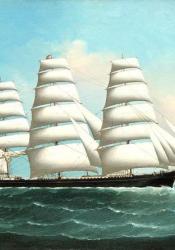The Age of Sail
From the mid 16th century to the mid 19th century, sailing was at its all-time peak. Its height began at the Battle of Lepanto in 1571 and ended during the Battle of Hampton Roads in 1862 (“Age of Sail”). In this last battle, the use of the steamship the CSS Virginia in the battle destroyed the still sailing ships and proved the power and feasibility of steam-powered sea travel (“Age of Sail”). Before the decline of sailing, there were many different types of sailing ships for the many different facets of water travel and exploration. At the beginning of this “Age of Sail”, the most commonly used ship was called a carrack (“Sailing ship”). These ships were popular because they had large cargo hold capabilities and were easiest for exploration (“Sailing ship”). In the 1700s, the ships that are popularized in history books are those used in war. Sailing warships are built to be able to carry a large load of war materials, including, cannons and cannonballs (“Sailing ship”). The most popular warship in this time period is called the man-of-war. In the early 1800s, Baltimore clippers became a highly popularized type of ship to use (“Sailing ship”). They were used to transport valuable, perishable cargo because of their high speeds (“Baltimore clipper”). They were also used to transport slaves (“Baltimore clipper”). Lastly, the last ship to experience a great amount of popularity during the “Age of Sail” was the iron-hulled sailing ship (“Sailing ship”). These ships also moved great loads of cargo like many before them (“Sailing ship”). After this, the age of sail had ended and steam-powered boats became a primary means of water travel, especially since it was more feasible at this time for steamships to travel on the Suez Canal (“Age of Sail”).
Oh, Lucy, I cannot imagine the despair that overtakes you, but I understand it all the same. You expect your sweet love to arrive home, safe from the outside world to hold in your arms but are met with nothingness. All you have left is the memories and moments you both once shared. My former husband left me a widower just ten fleeting years ago. I still think of him fondly. He set out to sail with his closest companions, leaving me with his children, the eldest bearing his name, Charles. My love told me he’d come back with the greatest of riches, but now, the greatest riches would be to just see his tender face one last time. I was given word that his boat sank, very similar to your own. They found the sails and flags on the shore, but not my Charles. If anything at all, we can say we loved and lost, but we will meet them again. It may be hard to bear the pain knowing your dear friends, Dr. John and Paulina, and Ginevra and Count De Hamal, are given the gift of seeing each other’s faces each day, but, we have the gift of a great guardian. While you both practiced separately, you may sleep soundly knowing that M. Paul is smiling upon you each and every night.
Brontë Charlotte. Villette. 1853, The COVE. https://studio.covecollective.org/documents/villette-2. Accessed 23 Sept 2020.
"File:Portrait of an American Clipper Ship.jpeg." Wikimedia Commons, the free media repository. 13 Oct 2019, 10:32 UTC. 23 Sep 2020, 18:52 <https://commons.wikimedia.org/w/index.php?title=File:Portrait_of_an_American_Clipper_Ship.jpeg&oldid=370381371>.
Wikipedia contributors. "Age of Sail." Wikipedia, The Free Encyclopedia. Wikipedia, The Free Encyclopedia, 30 Aug. 2020. Web. 23 Sep. 2020.
Wikipedia contributors. "Baltimore Clipper." Wikipedia, The Free Encyclopedia. Wikipedia, The Free Encyclopedia, 17 Sep. 2020. Web. 23 Sep. 2020.
Wikipedia contributors. "Sailing ship." Wikipedia, The Free Encyclopedia. Wikipedia, The Free Encyclopedia, 22 Sep. 2020. Web. 23 Sep. 2020.

